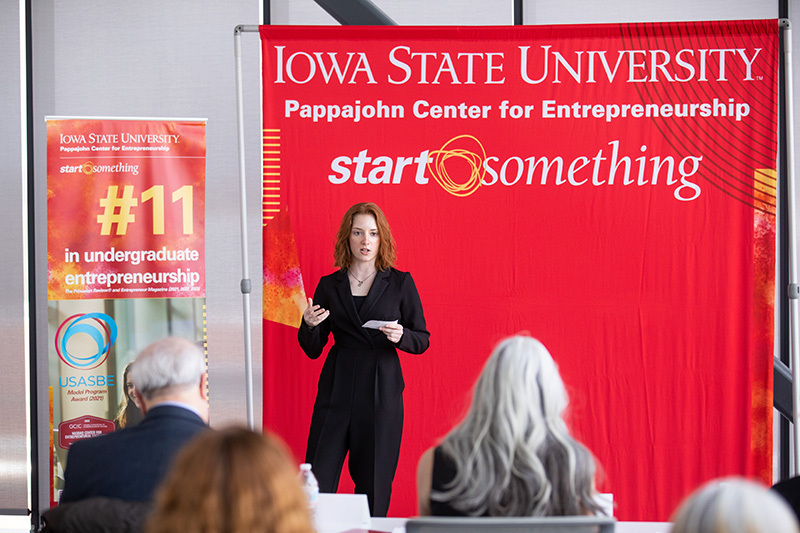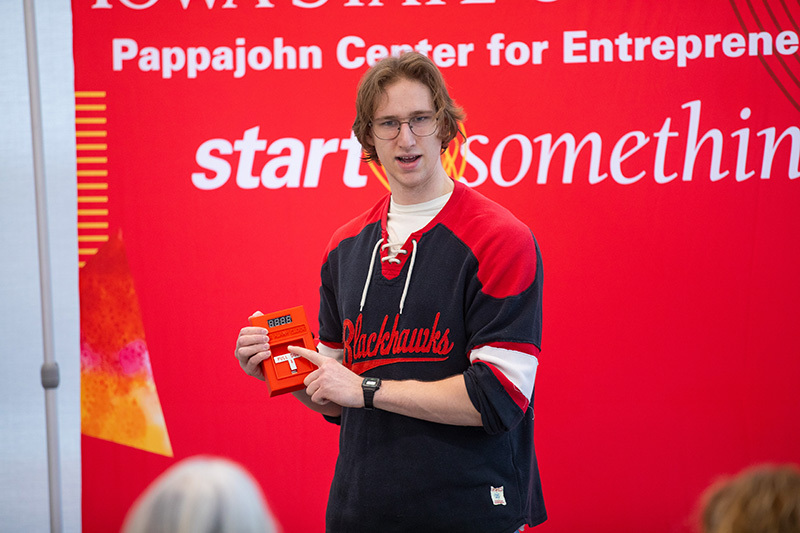Pitch-off growth reflects expanding interest in innovation
Author: Jeff Budlong
Author: Jeff Budlong

Junior Callan Randall presents during the college-by-college pitch competition finale at the Student Innovation Center on Feb. 27. Photos by Christopher Gannon.
Judi Eyles remembers when the pitch-off competition was a single day in the fall and spring semesters. That leisurely pace has been replaced by a mini-marathon for Pappajohn Center for Entrepreneurship staff -- especially during the spring when all seven colleges hold an individual pitch day. At the fall event, all students, regardless of college, pitch during one contest.
See the top finishers from each college in this spring's pitch-off competition.
The spring effort culminated Feb. 27 with the pitch finale in the Student Innovation Center. Winners from each college vyed for cash prizes for new and existing ideas.
"We have seen more students compete over the years,'' said the director of the Pappajohn Center for Entrepreneurship. "This year, we had to go to four days in the fall to accommodate all the people who wanted to pitch. Spring has become a college competition and the numbers continue to grow."
Eyles said 132 students pitched their idea during the spring competition, and participants continue to get younger with more freshmen and sophomores taking part.
"Students are hearing about innovation and entrepreneurship earlier -- even in high school -- and they are getting involved," Eyles said. "There are more courses in each college focusing on entrepreneurship. It's a far cry from 20 years ago when we would hear, 'I wish I had known about this before I was a senior.'
"The pitch competition is an easy first step for a student because a 90-second pitch is not overwhelming and can lead to other things," she added.
Eyles said successful pitch participants often advance their ideas to CYstarters, an 11-week summer accelerator to focus on a startup or business idea.
More instructors are using the pitch competition as a learning component in the classroom. Three instructors brought classes together last spring from different disciplines for "creative recess," making an interdisciplinary learning session led by students. Students worked on building pitches together, helping direct where instruction went.
"It is great, but it has caused a bit of a problem for us because we don't have enough room for all the students who want to pitch," Eyles said. "What we do now, we do a workshop in the class to teach them and then have them present in class. The top two finishers are guaranteed spots in the finale."
Instructors see the benefit that come from using the pitch contest as more than developing one idea. Eyles said learning to pitch teaches students how to speak in public and articulate a message, and it boosts their confidence.
Pappajohn staff also visit students in the classroom throughout the academic year to bring awareness to the pitch competition. Staff made more than 100 classroom visits this year, leading to an extra day -- called "overflow" -- added to hear all the spring pitches.
The seventh annual competition wrapped up Feb. 27 with 29 students presenting at the finale. The top two placers in each category -- new idea and existing business -- from each college competed, where the winners in each category took home $5,000. Second-place finishers received $2,500 awards, third took $1,500 and -- announced after all pitches were complete -- five students received $1,000 honorable mention awards.
David Spalding, Ivy College of Business dean and ISU vice president for economic development and industry relations
Dylan Kline, director of business development, Ames Chamber of Commerce and Economic Development Commission
Leah Locke, regional director, ISU Small Business Development Center
Julienne Shields, president, United States Association for Small Business and Entrepreneurship
The overall winner for best existing business -- for the second consecutive year -- was Cam Reiman, a senior in dietetics animal ecology, who pitched to the judges holding her blue-tongued skink (lizard). She sells NutriCubes, preportioned servings of blended ingredients for exotic animals.
The best new idea winner was Hala Deng, a senior in biology. She developed MedTrans, a medical translating device for patients that can break down medical jargon and relay it to the patient in simple, lay terms in real time. The device would give patients an understanding of complex medical terminology during consultations.
Other finale placers were:
New idea
Existing business

Senior Kadin Kruse presents his idea for an alarm clock that looks and works like a fire alarm to the judges during the college-by-college pitch competition finale.